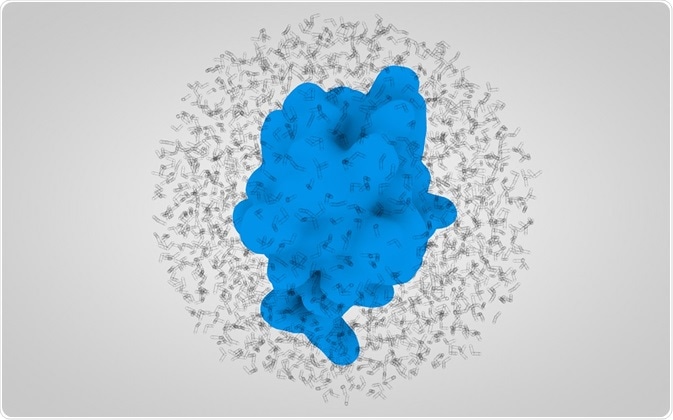
Types of Protein Post-Translational Modification
Post-translational modification (PTM) of proteins refers to the chemical changes that occur after a protein has been produced. It can impact the structure, electrophilicity and interactions of proteins.
 Credit: BiCyte/Shutterstock.com
Credit: BiCyte/Shutterstock.comTypes of post-translational modification
There are many typs of protein modification, which are mostly catalyzed by enzymes that recognize specific target sequences in proteins. These modifications regulate protein folding by targeting specific subcellular compartments, interacting with ligands or other proteins, or by bringing about a change in their functional state including catalytic activity or signaling. The most common PTMs are:
Based on the addition of chemical groups
- Phosphorylation
- Acetylation
- Hydroxylation
- Methylation
Based on the addition of complex groups
- Glycosylation
- AMPylation
- Lipidation
Based on the addition of polypeptides
- Ubiquitination
Based on the cleavage of proteins
- Proteolysis
Based on the amino acid modification
- Deamidation
Chemical groups
Phosphorylation
Reversible phosphorylation of proteins involves addition of a phosphate group on serine, threonine, or tyrosine residues and is one of the important and extensively studied PTM in both prokaryotes and eukaryotes.
Several enzymes or signaling proteins are switched ‘on’ or ‘off’ by phosphorylation or dephosphorylation. Phosphorylation is performed by enzymes called ‘kinases’, while dephosphorylation is performed by ‘phosphatases’.
Addition of a phosphate group can convert a previously uncharged pocket of protein into a negatively charged and hydrophilic protein thereby inducing conformational changes in the protein.
Phosphorylation has implications in several cellular processes, including cell cycle, growth, apoptosis and signal transduction pathways. One example is the activation of p53, a tumor suppressor protein. p53 is used in cancer therapeutics and is activated by phosphorylation of its N-terminal by several kinases.
Acetylation
Acetylation refers to addition of acetyl group in a protein. It is involved in several biological functions, including protein stability, location, synthesis; apoptosis; cancer; DNA stability. Acetylation and deacetylation of histone form a critical part of gene regulation.
Acetylation of histones reduces the positive charge on histone, reducing its interaction with the negatively charged phosphate groups of DNA, making it less tightly wound to DNA and accessible to gene transcription. Acetylation of p53, a tumor suppressor gene, is crucial for its growth suppressing properties.
Hydroxylation
This process adds a hydroxyl group (-OH) to the proteins. It is catalyzed by enzymes termed as ‘hydroxylases’ and aids in converting hydrophobic or lipophilic compounds into hydrophilic compounds.
Methylation
Methylation refers to addition of a methyl group to lysine or arginine residue of a protein. Arginine can be methylated once or twice, while lysine can be methylated once, twice, or thrice. Methylation is achieved by enzymes called methyltransferases. Methylation has been widely studied in histones wherein histone methylation can lead to gene activation or repression based on the residue that is methylated.
Complex groups
Glycosylation
Glycosylation involves addition of an oligosaccharide termed ‘glycan’ to either a nitrogen atom (N-linked glycosylation) or an oxygen atom (O-linked glycosylation). N-linked glycosylation occurs in the amide nitrogen of asparagine, while the O-linked glycosylation occurs on the oxygen atom of serine or threonine.
Carbohydrates present in the form of N-linked or O-linked oligosaccharides are present on the surface of cells and secrete proteins. They have critical roles in protein sorting, immune recognition, receptor binding, inflammation, and pathogenicity. For example, N-linked glycans on an immune cell can dictate how it migrates to specific sites. Similarly, it can also determine how a cell recognizes ‘self’ and ‘non-self’.
AMPylation
AMPylation refers to reversible addition of AMP to a protein. It involves formation of a phosphodiester bond between the hydroxyl group of the protein and the phosphate group of AMP.
Lipidation
The covalent binding of a lipid group to a protein is called lipidation. Lipidation can be further subdivided into prenylation, N-myristoylation, palmitoylation, and glycosylphosphatidylinositol (GPI)-anchor addition.
Prenylation involves the addition of isoprenoid moiety to a cysteine residue of a substrate protein. It is critical in controlling the localization and activity of several proteins that have crucial functions in biological regulation.
Myristoylation involves the addition of myristoyl group to a glycine residue by an amide bond. It has functions in membrane association and apoptosis. In palmitoylation, a palmitoyl group is added to a cysteine residue of a protein.
In GPI-anchor addition, the carboxyl-terminal signal peptide of the protein is split and replaced by a GPI anchor. Recent research in human genetics has revealed that GPI anchors are important for human health. Any defects in the assembling, attachment or remodeling of GPI anchors lead to genetic diseases known as inherited GPI deficiency.
Polypeptides
Ubiquitination
Ubiquitination involves addition of a protein found ubiquitously, termed ‘ubiquitin’, to the lysine residue of a substrate. Either a single ubiquitin molecule (monoubiquitination) or a chain of several ubiquitin molecules may be attached (polyubiquitination).
Polyubiquitinated proteins are recognized by the 26S proteasome and are subsequently targeted for proteolysis or degradation. Monoubiquitinated proteins may influence cell tracking and endocytosis.
Protein cleavage
Proteolysis
Proteolysis refers to breakdown of proteins into smaller polypeptides or amino acids. For example, removal of N-terminal methionine, a signal peptide, after translation leads to conversion of an inactive or non-functional protein to an active one.
Amino acid modification
Deamidation
Deamidation is the removal or conversion of asparagine or glutamine residue to another functional group. Asparagine is converted to aspartic acid or isoaspartic acid, while glutamine is converted to glutamic acid or pyroglutamic acid. This modification can change the protein structure, stability, and function.
Reviewed by Deepthi Sathyajith, MPharm.
Sources:
- Posttranslational modification. Science Direct Topics.
- Post translational modification. Delhi University
- Posttranslational Modification of p53: Cooperative Integrators of Function. CSHL perspectives in Biology
- Post translational modifications. Yale University.
- Kinoshita T. Glycosylphosphatidylinositol (GPI) Anchors: Biochemistry and Cell Biology: Introduction to a Thematic Review Series. J Lipid Res. 2016 Jan;57(1):4-5.
Further Reading
Last Updated: May 10, 2018


































No hay comentarios:
Publicar un comentario